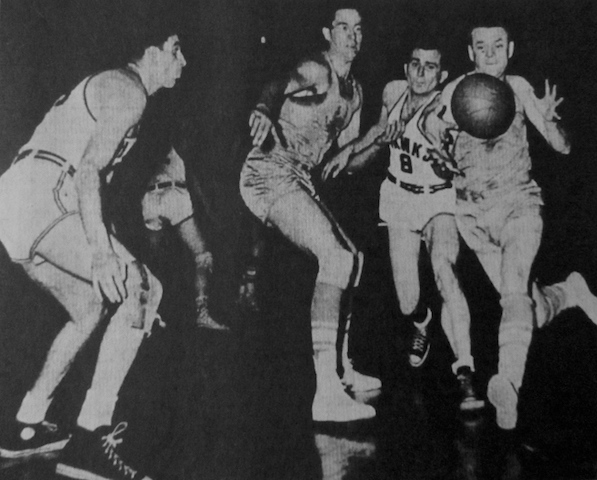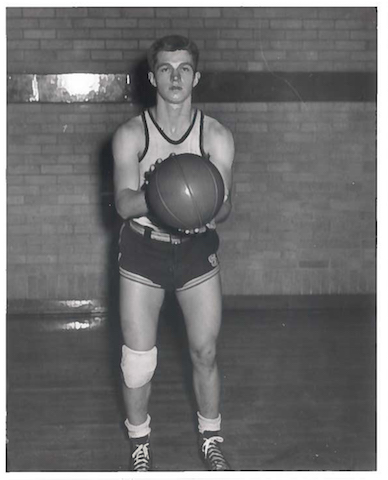
The NBA’s Waterloo Hawks hosted the Minneapolis Lakers on Dec. 31, 1949, at Waterloo’s Cattle Congress Hippodrome. The Hawks’ Harry Boykoff (far left) and Stan Patrick (second from right) defend the Lakers’ George Mikan (second from left) and Herman Schaefer (dribbling the ball). The Lakers went on to win the NBA Championship in the spring of 1950. Photo by Clyde Artus, courtesy of the Waterloo Courier
By Tim Harwood
When Leo Kubiak walked onto a professional basketball court for the first time, no one had ever heard of the National Basketball Association (NBA). There was no television crew there to commemorate the former college star’s initial steps across the sideline. Whatever enthusiasm or encouragement the 2,521 fans brought to the moment, Kubiak had played in front of far larger crowds while at Bowling Green State University. He was hundreds of miles from where he had expected to be when he signed his contract.

Leo Kubiak played professional basketball in Waterloo longer than any other player. Fans voted him the Waterloo Hawks’ Most Valuable Player during the team’s 1949-50 NBA season. Photo courtesy of Marketing & Communications, Bowling Green State University
Kubiak did not record a field goal or even attempt a free throw coming off the bench during his rookie debut for the Waterloo Hawks in early November 1948. Although the Hawks edged the Sheboygan Redskins 64-61 that evening, it was an obscure beginning for the player who would appear in more games than anyone else during the brief period when Waterloo was a professional basketball city. Kubiak had a better showing three nights later, producing 12 points (two in overtime) to help lift the home team past the Denver Nuggets, 51-48.
Just having a “home team” at Waterloo’s Cattle Congress Hippodrome would have seemed unlikely several months earlier.
“The Toledo [Ohio] Jeeps were in the National Basketball League (NBL),” remembered Kubiak, a Toledo native. “Although I was drafted by the Rochester Royals of the Basketball Association of America (BAA), I stayed in Ohio and somehow went along with the Jeeps to Waterloo.”
There are good reasons the particulars of Kubiak’s path to northeast Iowa might seem hazy seven decades after Toledo’s loss became Waterloo’s gain. For one thing, Kubiak was in Green Bay, Wis., playing professional baseball during the summer of 1948. As the Jeeps were being relocated, Kubiak was taking his swings as a prospect in the Cleveland Indians farm system, now known as the Cleveland Guardians.
The prevailing instability of professional basketball in the years following World War II — particularly the duel-to-the-death happening between the NBL and the BAA — also made the appearance and disappearance of teams a commonplace occurrence. The NBL had been established in the 1930s as the United States slowly shook off the effects of The Great Depression. Playing in small to mid-sized Midwestern industrial cities, its leading clubs scraped through the war years, hoping to find prosperity during the peace which was expected to follow. Instead, the NBL was challenged to compete for players and prestige by the BAA beginning in the fall of 1946. The new association played in the country’s big-league cities (Boston, New York, Philadelphia, Chicago) and in renowned facilities like Madison Square Garden.
However, large markets and palatial venues were not enough to make the BAA successful. The NBL already had many of the top professionals under contract and could often make a compelling case when college graduates like Kubiak were being courted by both circuits, particularly when geographic considerations were favorable.
Soon, both leagues would merge to form the National Basketball Association and the Waterloo Hawks would open their 62-game NBA campaign of 1949-50.
TO READ THE ENTIRE STORY AND OTHER FASCINATING STORIES ABOUT IOWA HISTORY, subscribe to Iowa History Journal.
